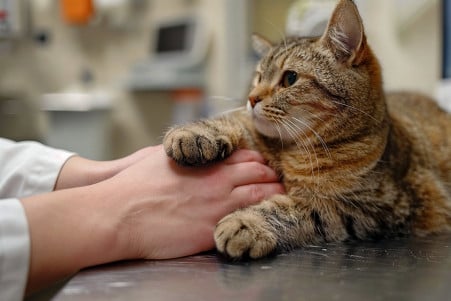The Truth About Declawing Dogs: Ethical Considerations
6 May 2024 • Updated 4 May 2024

How ethical is declawing dogs, a surgical procedure that involves amputating the end bones of a dog's toes? Declawing dogs is widely recognized as animal abuse by the veterinary community and animal welfare organizations. The procedure can lead to extreme pain, infection, tissue necrosis, lameness, and other long-term issues for the animal. In addition, there are risks associated with general anesthesia and potential behavioral issues after the surgery. As a result, declawing dogs is illegal in many countries and states.
By closely examining veterinary clinical research, animal behavior studies, and expert insights, we will take a deep dive into the declawing process to determine the short-term and potential lifelong effects on a dog's physical and psychological well-being. This will help give pet parents a well-rounded view that will help them make an informed, ethical decision about elective declawing surgeries.
Is declawing dogs an ethical practice?
What Do the Experts Say About Declawing Dogs?
The American Veterinary Medical Association (AVMA) and the Humane Society Veterinary Medical Association (HSVMA) are among the major veterinary organizations that have come out strongly against declawing dogs, except in cases of medical necessity. They believe the procedure is inhumane and unjustified, as there are no proven benefits to the dog’s health or welfare. The AVMA’s updated policy leaves the decision up to the veterinarian but urges the consideration of alternatives and the use of appropriate pain management if declawing is chosen.
In addition to the major veterinary associations, many individual veterinarians and animal behaviorists have spoken out against declawing dogs, noting the potential for complications, pain, lameness, and behavioral issues, as pointed out by the Australian Veterinary Association. Some have even gone as far as to say that declawing dogs is as inhumane as declawing cats, a practice that is increasingly being outlawed according to the American Animal Hospital Association.
Given the strong stance of the major veterinary organizations against declawing dogs, except in cases of medical necessity, and the warnings of individual experts about the potential negative effects of the procedure, the evidence is clear that declawing dogs is widely discouraged by the veterinary community due to ethical concerns about animal welfare.
The Process of Declawing and Its Effects on Dogs
The declawing process, also known as onychectomy, involves the amputation of the entire third phalanx (bone) of each toe on a dog, not just the claw or nail. According to the Days of the Dog website, this surgery can result in a number of short- and long-term issues, including chronic pain, infection, lameness, and arthritis.
Since dogs use their claws for balance, movement, and instinctive activities like scratching and digging, declawing can have a major impact on their physical and mental health. The Country K9 Pet Resort & Spa explains that declawed dogs can have trouble walking, running, and doing normal things because of the loss of their claws and the pain that comes with it.
In addition to physical problems, declawed dogs are often more likely to have problems like anxiety, aggression, and urinating inappropriately, as reported by Wag!. The PMC study on surgical and behavioral relationships with animal welfare also shows that physical procedures can have a negative effect on an animal's mental state and overall welfare.
What Can I Do Instead of Declawing My Dog?
Instead of declawing, experts suggest that the underlying issues that lead to unwanted scratching or digging behaviors can be managed through positive reinforcement training and environmental changes. The Mercury News explains that providing scratching posts, toys, and enrichment can help dogs redirect their natural scratching behaviors.
In addition, regular nail trimming, nail caps, or deterrent products like SoftPaws, and treating any stress or anxiety can help prevent destructive scratching, according to Centre County PAWS. If a dog's nails are causing a risk of injury, partial or temporary claw removal may be an option of last resort that is done under the care of a veterinarian.
In general, experts agree that declawing should not be done as a routine or convenience surgery because there are other options that are more humane and effective, as the American Veterinary Medical Association points out.
The Legal and Regulatory Environment of Declawing Dogs
Although declawing dogs is currently legal in many countries and states, some areas have enacted bans or restrictions on the procedure due to concerns about animal welfare. The Animal Legal & Historical Center reports that a number of U.S. states and local governments have passed laws that prohibit the elective declawing of companion animals, although there are exceptions for medical reasons.
In addition, some veterinary practices have implemented policies that limit declawing to cases of medical necessity or therapeutic reasons. Nevertheless, the Humane Society Veterinary Medical Association says that the legal status of declawing dogs is still “inconsistent and largely unregulated” in many areas, which has led to ongoing controversy and calls for more comprehensive laws.
Given the increasing attention and concern about the ethics of declawing, it’s likely that more areas will consider enacting stricter laws or even banning the procedure altogether. In fact, the Australian Veterinary Association has come out strongly against declawing and other non-therapeutic surgeries, arguing that the welfare of animals should take precedence over the convenience of humans.
Responsible Pet Ownership and Ethical Considerations
Declawing dogs is often viewed as a procedure of convenience for the owner rather than a medically necessary one, leading to ethical concerns about human interests being prioritized over animal welfare. According to the LA Dog Trainer & Behaviorist, the same is true of docking a dog's tail or cropping its ears for cosmetic reasons. Responsible pet ownership means that pet owners understand and accept a dog's natural instincts and behaviors instead of trying to change them through invasive and potentially dangerous surgeries.
Training, managing the dog's environment, and addressing any behavioral problems that may be causing the unwanted behavior are all cited as more ethical and humane ways to deal with scratching or digging issues by RexiPets. In the end, the choice to declaw a dog should be made with full awareness of the potential risks, consequences, and ethical concerns and only after all other options have been exhausted. Pet owners should make an effort to learn the truth about declawing and put their dog's welfare ahead of their own convenience or aesthetic desires.
Conclusion: A More Compassionate Way to Care for Pets
The evidence and expert opinions presented in this article show that declawing dogs is widely recognized as an inhumane and unnecessary practice that can lead to serious physical and psychological harm. Both the American Veterinary Medical Association (AVMA) and the Humane Society Veterinary Medical Association (HSVMA) have issued strong statements against declawing, except in cases of medical necessity, and have recommended other, more humane options.
Being a good pet owner means learning to live with and manage a dog’s natural behaviors instead of resorting to invasive procedures to change them for your own convenience. By focusing on their pet’s welfare and working to manage any unwanted behaviors through positive reinforcement training, environmental management, and addressing the root causes, pet owners can take a more compassionate and ethical approach to pet care.
In the end, the choice to declaw a dog should be made after carefully considering the potential risks, consequences, and ethical concerns, and only after all other options have been exhausted.


